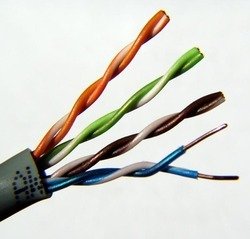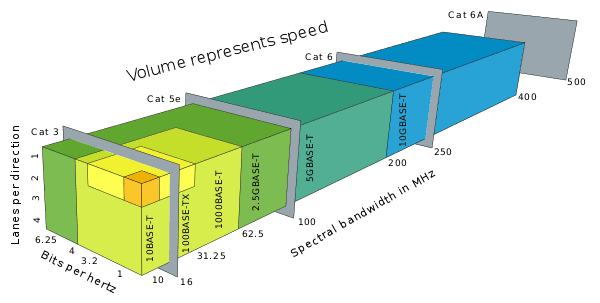In computer networking, Fast Ethernet physical layers carry traffic at the nominal rate of 100 Mbit/s.
What is 100Base TX cable?
The 100Base TX cable, or 100BaseT, is one of the most popular Ethernet signal cables. It replaced 10Base-T and 10Base-2 coaxial cables in the past. A 100Base–TX speed is up to 100 Mbps. The 100Base–TX distance: the maximum length is 100 meters, and its minimum length between nodes is 2.5 meters.
- 100: This refers to the data transmission rate of 100 Mbps (megabits per second).
- Base: This stands for baseband. In baseband transmission, the entire bandwidth of the cable is used for a single data signal. This contrasts with broadband transmission, where the cable simultaneously carries several signals at different frequencies.
- TX: This stands for two-pair star extended, but in simpler terms, the cable uses two pairs of wires.
100Base-T utilizes two sets of wires in the Category 5 UTP link at any rate, while 100Base-TX requires two sets in Category 6. 100Base-T4 utilizes each of the four-wire locations in more established Category 3 links.

The 100Base-TX cable, also known as 100BaseT, is an Ethernet standard that transmits data at 100 Mbps using two pairs of Category 5 UTP wires over distances up to 100 meters, with a minimum recommended length of 2.5 meters between nodes. This baseband transmission technology, signified by “Base,” uses the entire bandwidth for a single data signal, differentiating it from broadband, and the “TX” denotes its two-pair wire configuration.
What is the speed of the 100-base-tx cable?
Presented in 1995 and authoritatively the IEEE 802.3u norm, 100Base-T is a 100 Mbps variant of the 10 Mbps 10Base-T. Like 10Base-T, 100Base-T is a standard media LAN when utilized with a center (all hubs share 100 Mbps) and 100 Mbps between each pair of hubs when used with a switch. All cutting-edge Ethernet gadgets are 10/100/1000, supporting 10, 100, and 1000 Mbps (10Base-T, 100Base-T, and 1000Base-T).
In 100 Mbps (megabits every second) Ethernet (known as Fast Ethernet), three kinds of actual wiring can convey signals:
- 100BASE-T4 (four sets of phone wound pair wire)
- 100BASE-TX (two sets of information grade wound pair wire)
- 100BASE-FX (a two-strand optical fiber link)
100Base-TX Cable Characteristics:
- Data Rate: 100Base-TX cables are designed to support data transmission rates up to 100 Mbps (hence the “100” in 100Base-TX).
- Maximum Segment Length: The maximum length of a 100Base-TX segment, which means the distance between two devices (like a computer and a switch or two switches), is 100 meters (about 328 feet). If you exceed this length without proper equipment (like repeaters or switches), the signal quality can degrade, leading to data transmission errors.
- Minimum Recommended Node Length: It’s a bit less well-known, but in Ethernet installations, especially when working with hubs, there’s a recommendation concerning the minimum cable length between two connected devices to prevent “signal reflection.” For 100Base-TX, the recommended minimum cable length is 2.5 meters between devices. This ensures that signals from one device have enough time to dissipate before returning signals reach it, reducing the chances of collision-induced errors.
This minimum length recommendation is particularly significant in network configurations where hubs connect devices in a daisy chain. This is less of a concern in modern switched networks because switches operate in full-duplex mode, eliminating collisions.
To give an analogy, Think of the signal as a sound wave in a long tunnel. If you shout into one end of a very short tunnel, the echo (or reflection) comes back almost immediately, potentially jumbling with any new sounds you make. A longer tunnel gives that echo more time to fade before it returns to you.
In Summary: The 100Base-TX standard specifies that:
- The data transmission rate is up to 100 Mbps.
- The maximum segment length of the cable between devices is 100 meters to maintain signal integrity.
- To prevent signal reflection issues, especially in older hub-based networks, a minimum cable length of 2.5 meters between devices is recommended.
Adhering to these specifications can help ensure reliable data transmission when designing or troubleshooting a network.
100Base-TX Specifications:
- Transmission Medium: 100Base-TX uses two Category 5 unshielded twisted pair (UTP) cables. One pair transmits data, and the other receives data. However, enhanced versions like Category 5e (Cat 5e) or higher-quality cables can also be used.
- Distance/Length: The maximum segment length (the distance between two connected devices, such as a computer and a switch) is 100 meters (328 feet).
- Data Rate: As the name implies, it supports data rates up to 100 Mbps.
- Topology: Typically used in a star topology, all workstations are individually connected to a central hub or switch.
- Encoding: Uses 4B5B (4-bit/5-bit) encoding to transmit data.
- Physical Connector: The standard physical connector is the RJ-45, which looks like a giant telephone jack.
Applications:
100Base-TX is primarily used for fast Ethernet networks. Even though faster standards are available, like Gigabit Ethernet (1000Base-T), 100Base-TX is still found in many older installations and is often supported by modern hardware for backward compatibility.
Advantages:
- It offers a significant speed boost compared to its predecessor, 10Base-T, which operated at 10 Mbps.
- Utilizes the famous and widely available Cat 5 UTP cabling.
- Compatible with many existing Ethernet installations and devices.
Limitations:
- They are limited to 100 Mbps, while newer standards offer higher speeds.
- Limited to a distance of 100 meters, after which signal repeaters or switches are required.
To summarize, 100Base-TX is a fast Ethernet standard that utilizes two Cat 5 UTP cables to transmit and receive data at rates up to 100 Mbps. The standard has been widely adopted due to its speed and ease of implementation but has since been overshadowed by faster Ethernet standards. Nonetheless, it remains an essential part of networking history and continues to be used in various applications.
Ethernet over twisted pair technologies use twisted-pair cables for the physical layer of an Ethernet computer network:

This assignment is a shorthand identifier for the Institute of Electrical and Electronics Engineers. The “100” in the media type assignment alludes to the transmission speed of 100 Mbps. The “BASE” alludes to baseband flagging, which implies that solitary Ethernet signals are carried on the medium. The “T4,” “TX,” and “FX” allude to the actual medium that conveys the sign. (Through repeaters, media portions of various actual sorts can be utilized in a similar framework.)
The TX and FX types together are at times alluded to as “100BASE-X.” (The assignment for “100BASE-T” is likewise at times observed as “100BaseT.”)
An Ethernet standard that communicates at 100 Mbps. Presented in 1995 and formally the IEEE 802.3u norm, it is a 100 Mbps rendition of 10Base-T (10 Mbps Ethernet). All cutting-edge Ethernet gadgets are at any rate 10/100, supporting both 100Base-T and 10Base-T (see 10/100 adapter).100Base-T, 100Base-T4, and 100Base-TX100Base-T utilize two sets of wires in Category 5 UTP link, while 100Base-TX requires two sets in Category 6 link. 100Base-T4 uses each of the four-wire groups in more established Category 3 links. See 10Base-T and 100Base-FX.
- Facebook Ads to Get Followers! - December 27, 2024
- ClickUp vs. Slack - December 20, 2024
- Mastering E-Commerce Analytics: A Blueprint for Success





